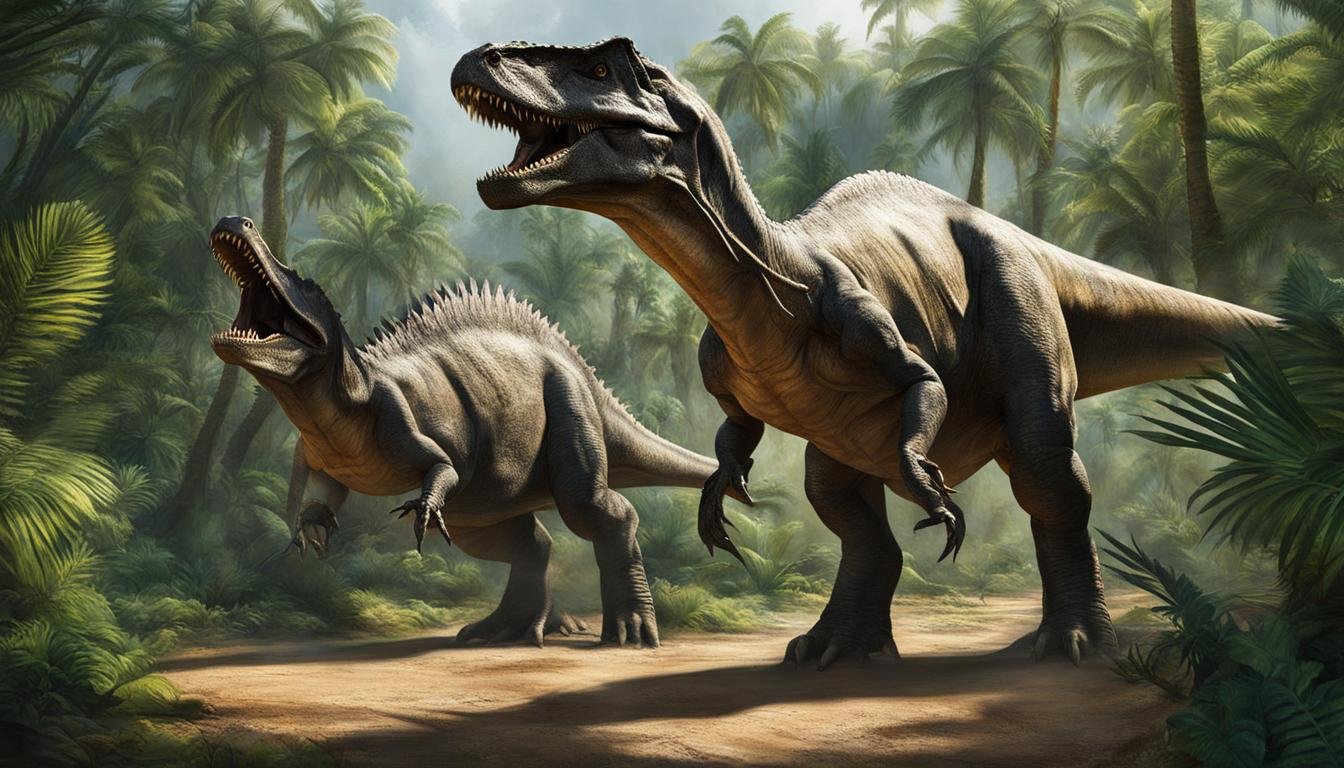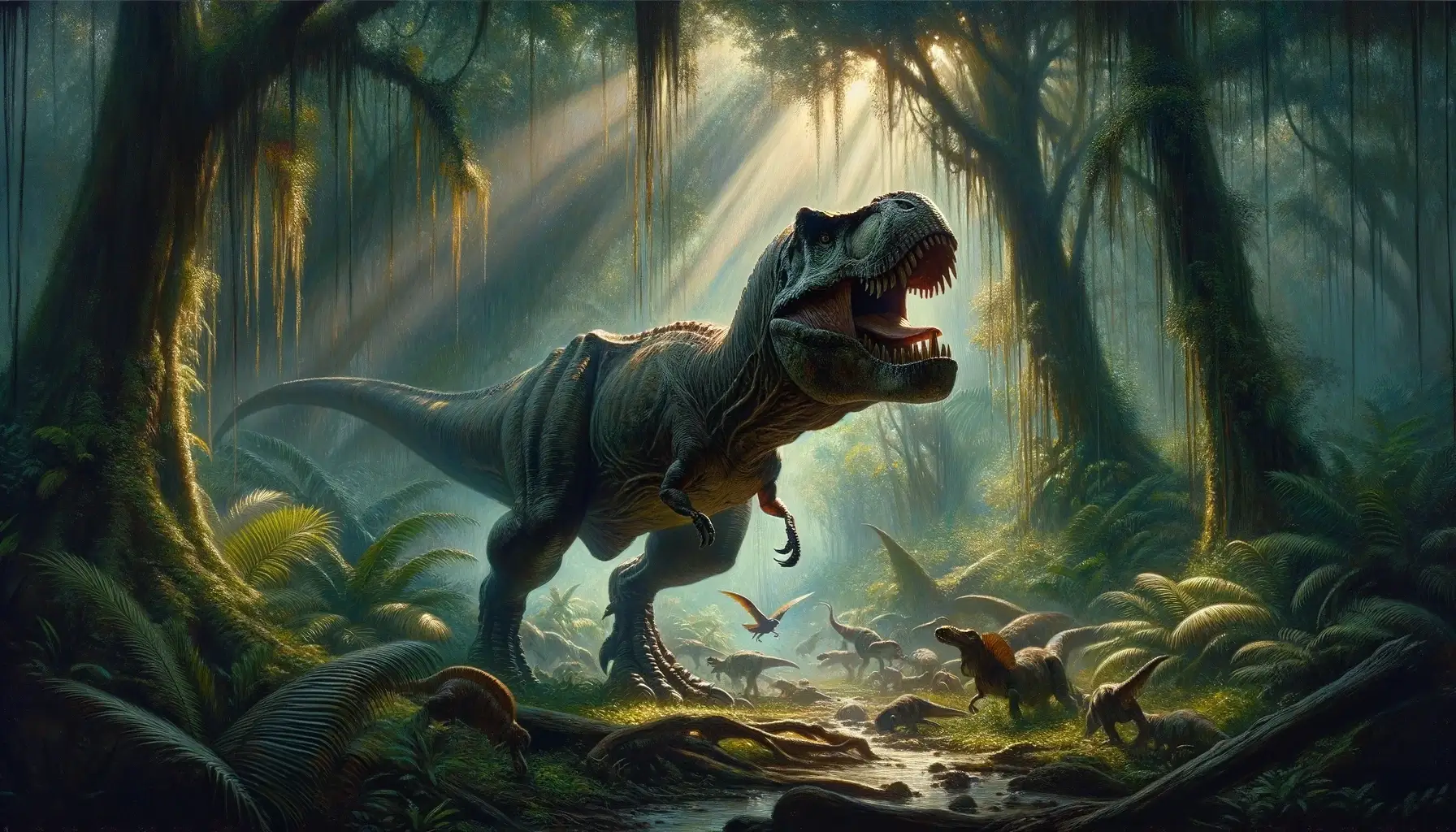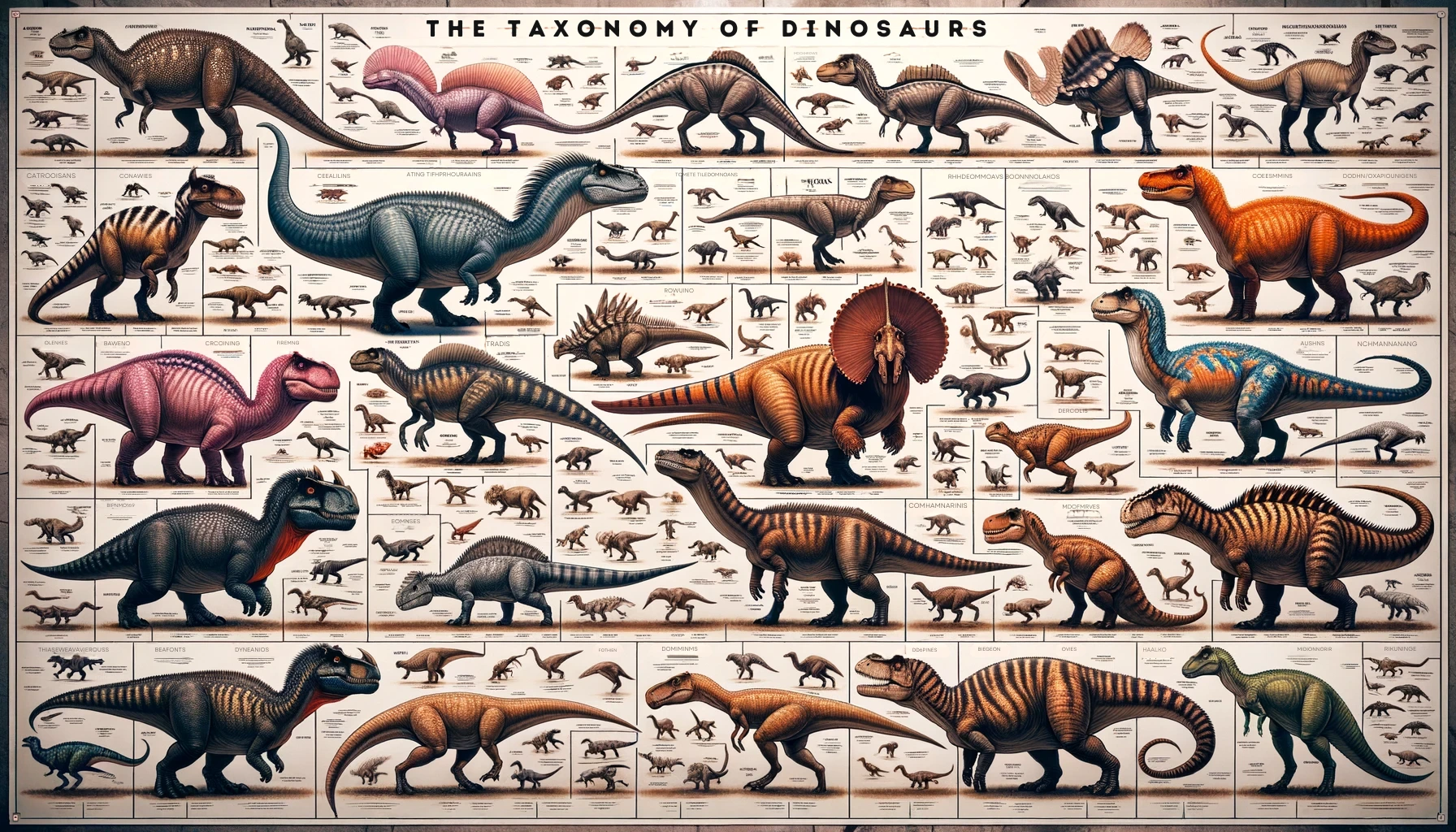The era of dinosaurs was a time of gigantic creatures roaming the Earth, but not all of them were ferocious carnivores. Among these ancient behemoths were the herbivorous dinosaur types, a special group that thrived on a diet of plants and other non-animal food sources. Being a herbivore in a world filled with predators had its advantages and challenges. The herbivores often had size and strength on their side, enabling them to reach high foliage for sustenance. However, their plant-based diet meant they had to constantly forage for food while evading or fending off predators.
The purpose of this article is to delve into the fascinating realm of herbivorous dinosaur types, shedding light on the different groups and their unique characteristics. As we journey back in time, we’ll explore the distinctive features that set apart the plant-eating dinosaurs, or herbivore dinosaurs, from their meat-eating counterparts.

The Main Groups of Herbivorous Dinosaur types
Herbivorous dinosaurs mainly fall into two broad categories: the Ornithischians and Sauropodomorphs. These groups exhibit distinct physical attributes and evolutionary traits that contributed to their survival in the prehistoric world.
| Group | Defining Features | Common Traits | Example Dinosaurs | Description |
| Ornithischians | Bird-like hip structure, Beak-like mouths | Armor plates, horns, spikes, and frills. Predominantly quadrupedal stance, Varied size and form | Triceratops, Stegosaurus, Ankylosaurus | Specialized plant-eaters with defensive mechanisms and a variety in size/form |
| Sauropodomorphs | Long neck and tail, Small head | Large size, Quadrupedal stance, Peg-like teeth | Brachiosaurus, Diplodocus, Brontosaurus | Majestic gentle giants with body forms allowing high browsing on vegetation |
Ornithischians: The Bird-Hipped Dinosaurs
Among the herbivorous dinosaur types, the Ornithischians stand out with their bird-like hip structure, a unique characteristic that played a pivotal role in their mobility and lifestyle. Their hip structure is so named due to its resemblance to the pelvic structure of modern birds. Additionally, their beak-like mouths were particularly adept at cropping vegetation, making them a specialized group of plant-eaters in a world of diverse dietary adaptations.
Some common features of Ornithischians include:
- Armor plates, horns, spikes, and frills, which not only served as defense mechanisms against predators but also possibly played a role in thermoregulation and sexual display.
- Predominantly quadrupedal stance, though some species had the ability to assume a bipedal stance when necessary.
- A variety in size and form, ranging from small, agile dinosaurs to large, heavily armored behemoths.
Let’s delve into some examples of Ornithischian dinosaurs:
- Triceratops: Known for its three prominent horns and a large frill on its neck, Triceratops was a formidable herbivore. The frill possibly played a role in defense, thermoregulation, and visual display.
- Stegosaurus: This dinosaur carried two rows of large bony plates along its back and four sharp spikes on its tail, which could have been used defensively against predators.
- Ankylosaurus: A living tank, Ankylosaurus boasted a club-like tail and bony armor covering its body, providing it with robust protection against predators.
Sauropodomorphs: The Long-Necked Dinosaurs
The Sauropodomorphs, on the other hand, are often depicted as the gentle giants of the dinosaur realm. Their defining characteristics, including a long neck and tail coupled with a small head, set them apart. These dinosaurs were the true long-necked behemoths of the prehistoric era, with body forms that were both majestic and functional.
Some common features of Sauropodomorphs include:
- Large size which was instrumental in reaching high vegetation others couldn’t access.
- Quadrupedal stance to support their massive bodies and high browsing behavior, reaching foliage far above the ground.
- Small heads with peg-like teeth for stripping leaves off branches, a feature that emphasizes their herbivorous nature.
Here are some examples of Sauropodomorph dinosaurs:
- Brachiosaurus: With a height that could reach up to 40 feet, Brachiosaurus could browse on vegetation unavailable to other herbivores. Its longer front legs allowed it to reach even higher, making it one of the most iconic long-necked dinosaurs.
- Diplodocus: Characterized by its slender body, a long neck, and an even longer tail, Diplodocus was a spectacle of the ancient world. Its peg-like teeth were ideal for a herbivorous diet.
- Brontosaurus: The massive Brontosaurus, with its long neck and tail, represented a classic image of what many envision when thinking of dinosaurs. Despite its colossal size, it was a gentle plant-eater, browsing on the lush prehistoric foliage.
The diverse adaptations of herbivorous dinosaur types reflect a complex evolutionary journey driven by the need for survival in a world where being a plant-eater came with both opportunities and challenges. As we dig deeper, the lifestyle and survival strategies of these plant-eating giants reveal a fascinating chapter in Earth’s prehistoric saga.

How to Identify Differences between Herbivorous Dinosaurs Types
Identification of herbivorous dinosaur types can be an enthralling exploration into the past, allowing us to piece together the complex puzzle of prehistoric life. By honing in on certain physical features, it’s possible to categorize these ancient giants into their respective herbivorous groups. Here are some handy tips to help recognize different types of herbivorous dinosaurs based on their distinct features:
| Identification Features | Herbivorous Dinosaurs | Carnivorous Dinosaurs |
| Teeth | Flat or peg-like teeth for grinding or stripping plants | Sharp or serrated teeth for tearing flesh |
| Skull | Small or narrow skulls with beaks or snouts | Large or wide skulls with powerful jaws |
| Limbs | Four sturdy legs for supporting weight or navigating uneven terrain | Two long legs for running or jumping, and two short arms for grasping or slashing |
| Body Shape | Bulky or elongated bodies for food storage or reaching high foliage | Streamlined or agile bodies for swift hunting or evasion |
Look at the Teeth
Dental morphology is a telling indicator of a dinosaur’s dietary preference:
- Herbivorous dinosaurs possessed flat or peg-like teeth suitable for grinding or stripping plants.
- On the flip side, carnivorous dinosaurs had sharp or serrated teeth designed for tearing flesh apart.
The difference in dental structure paints a vivid picture of the dietary adaptations these ancient creatures had to undergo to survive in their respective niches.
Look at the Skull
The design of a dinosaur’s skull provides insight into its feeding habits:
- Herbivorous dinosaurs usually had small or narrow skulls with beaks or snouts, adaptations that aided in cropping vegetation.
- Carnivorous dinosaurs, however, had large or wide skulls with powerful jaws capable of crushing bone and tearing flesh.
The contrasting skull structures reflect the diverging evolutionary paths taken by herbivores and carnivores.
Look at the Limbs
The limbs of a dinosaur are indicative of its lifestyle and dietary habits:
- Herbivorous dinosaurs typically had four sturdy legs for supporting their hefty weight or navigating uneven terrain in search of vegetation.
- Carnivorous dinosaurs, on the other hand, often had two long legs for running or jumping and two short arms for grasping or slashing their prey.
The disparity in limb structure and function illustrates the evolutionary trade-offs between predation and herbivory.
Look at the Body Shape
A dinosaur’s body shape can also provide clues to its diet:
- Herbivorous dinosaurs often had bulky or elongated bodies, adaptations that allowed for ample food storage or enabled them to reach high foliage.
- Carnivorous dinosaurs usually showcased streamlined or agile bodies, a design facilitating swift hunting or evasion.
The contrasting body shapes between herbivorous and carnivorous dinosaurs underscore the different survival strategies adopted by these prehistoric beings.
Unveiling the mysteries behind herbivorous dinosaur types and their carnivorous counterparts is like opening a window to a bygone era. By examining the teeth, skull, limbs, and body shape, we can draw closer to understanding the lifestyle and behaviors of these ancient behemoths. Through each bone and fossil, we uncover a story, a glimpse into a world where survival hinged on adaptation to one’s environment and dietary habits.

How Herbivorous Dinosaur Types Lived and Survived
The realm of herbivorous dinosaurs was a vivid tableau of social interactions, migration, and survival strategies. These gentle giants of the prehistoric world were pioneers in adapting to the challenges thrown at them by nature’s whims.
Lifestyle and Behavior of Herbivorous Dinosaur Types
Herbivorous dinosaurs exhibited complex behaviors akin to a grand drama played over millions of years:
- Social Interactions: Many herbivorous dinosaurs were believed to have lived in herds or flocks, a strategy that provided safety in numbers against predators. Their social hierarchy and group dynamics were possibly as diverse as the dinosaur species themselves.
- Migration Patterns: To satiate their endless appetite for vegetation, some herbivorous dinosaurs migrated long distances in search of fresh pastures, showcasing a remarkable sense of direction and purpose.
- Reproduction Strategies: Reproduction was a grand venture for these dinosaurs. From courtship displays to nurturing the young, every stage was crucial for the perpetuation of the species.
Challenges and Threats for Herbivorous Dinosaur Types
Life wasn’t a bed of roses for these plant-eating leviathans:
- Food Scarcity: With their gigantic size, herbivorous dinosaurs required vast amounts of food, making food scarcity a genuine concern.
- Climate Change: Changes in climate had a direct impact on vegetation, affecting the food source of these gentle giants.
- Predators: Predation was a constant threat. Despite their size, herbivorous dinosaurs were often at the mercy of ferocious carnivorous dinosaurs.
Overcoming Challenges
Herbivorous dinosaurs displayed a plethora of adaptations and strategies to mitigate these challenges:
- Camouflage: Some herbivores had skin patterns that helped them blend with their surroundings, providing a cloak of invisibility against predators.
- Communication: Vocalizations and body language likely played a crucial role in alerting herd members of impending danger or directing them to food sources.
- Cooperation: Working together as a cohesive unit during times of threat or while foraging, showcased the epitome of cooperative behavior.

Conclusion
Herbivorous dinosaur types represent a diverse and fascinating chapter in Earth’s evolutionary narrative. This article shed light on the two primary groups of herbivorous dinosaurs, Ornithischians and Sauropodomorphs, and how to identify them based on distinct physical traits. The life and times of these plant-eating dinosaurs unveil a saga of survival, adaptation, and social interactions.
Here are some enthralling tidbits to conclude our journey into the world of herbivorous dinosaurs:
- Social Life: The camaraderie among some herbivorous dinosaurs is awe-inspiring, with evidence suggesting a rich social life within herds.
- Defensive Display: The armory of horns, spikes, and frills were not just for defense but possibly played a part in display behaviors for attracting mates or asserting dominance.
- Digestive Wonders: Digesting tough plant material is no small feat, yet herbivorous dinosaurs were up to the task. Some species likely harbored gut bacteria for breaking down cellulose, while others utilized gastroliths (stones in the stomach) to grind plant matter.
The enchanting world of herbivorous dinosaurs offers a glimpse into nature’s boundless creativity and the inexorable spirit of survival that defines the essence of life on Earth.








